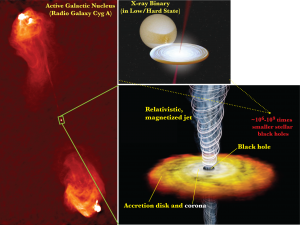
Compact objects include black holes, neutron stars and white dwarfs. All of these objects can capture surrounding material via their gravitational fields, leading to a process called accretion, in which the matter infalls towards the central object. Because the accreted matter usually has angular momentum, it settles into circular orbits which form accretion disks over time, because of dissipation and angular momentum transfer. Most sources with accretion disks are associated with mysterious and powerful bipolar outflows of plasma, called jets.
My current interest is to understand how jets form and relate to the accretion flow in accreting compact objects of all mass and power scales. To this end, I have been primarily focusing on low disk-luminosity systems, where the jet emission is likely more dominant. This includes X-ray binaries in the hard/quiescent states, and low-luminosity AGN such as NGC 4258, M81* and our own Galactic center supermassive black hole, Sgr A*. I am also interested in the high-energy particle processes which ultimately lead to much of the emission we detect from these objects.
I pursue these studies using both theoretical (modeling) approaches and by obtaining new data from the radio through X-ray, and hopefully soon also gamma-ray frequencies.
I am also interested in science education and outreach.
Links to Our Current Research
Background: Accretion and Jet Production
Our Group’s Research – Theoretical: Modeling Relativistic Jets
Our Group’s Research – Observations of Jets from Black Holes
Our Group’s Research – Accreting Objects and their Environments
Group Members
